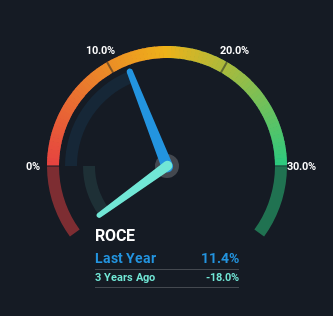If you’re not sure where to start when looking for the next multi-bagger, there are a few key trends you should keep an eye out for. Ideally, a business will show two trends; firstly a growing return on capital employed (ROCE) and secondly, an increasing amount of capital employed. Basically this means that a company has profitable initiatives that it can continue to reinvest in, which is a trait of a compounding machine. With that in mind, we’ve noticed some promising trends at Air Canada (TSE:AC) so let’s look a bit deeper.
What Is Return On Capital Employed (ROCE)?
For those that aren’t sure what ROCE is, it measures the amount of pre-tax profits a company can generate from the capital employed in its business. The formula for this calculation on Air Canada is:
Return on Capital Employed = Earnings Before Interest and Tax (EBIT) ÷ (Total Assets – Current Liabilities)
0.11 = CA$2.3b ÷ (CA$30b – CA$10b) (Based on the trailing twelve months to December 2023).
Therefore, Air Canada has an ROCE of 11%. In absolute terms, that’s a satisfactory return, but compared to the Airlines industry average of 8.9% it’s much better.
View our latest analysis for Air Canada
Above you can see how the current ROCE for Air Canada compares to its prior returns on capital, but there’s only so much you can tell from the past. If you’d like to see what analysts are forecasting going forward, you should check out our free analyst report for Air Canada .
What Can We Tell From Air Canada’s ROCE Trend?
The trends we’ve noticed at Air Canada are quite reassuring. The data shows that returns on capital have increased substantially over the last five years to 11%. The company is effectively making more money per dollar of capital used, and it’s worth noting that the amount of capital has increased too, by 25%. The increasing returns on a growing amount of capital is common amongst multi-baggers and that’s why we’re impressed.
The Key Takeaway
In summary, it’s great to see that Air Canada can compound returns by consistently reinvesting capital at increasing rates of return, because these are some of the key ingredients of those highly sought after multi-baggers. Astute investors may have an opportunity here because the stock has declined 44% in the last five years. With that in mind, we believe the promising trends warrant this stock for further investigation.
Air Canada does have some risks, we noticed 2 warning signs (and 1 which is a bit concerning) we think you should know about.
While Air Canada isn’t earning the highest return, check out this free list of companies that are earning high returns on equity with solid balance sheets.
Have feedback on this article? Concerned about the content? Get in touch with us directly. Alternatively, email editorial-team (at) simplywallst.com.
This article by Simply Wall St is general in nature. We provide commentary based on historical data and analyst forecasts only using an unbiased methodology and our articles are not intended to be financial advice. It does not constitute a recommendation to buy or sell any stock, and does not take account of your objectives, or your financial situation. We aim to bring you long-term focused analysis driven by fundamental data. Note that our analysis may not factor in the latest price-sensitive company announcements or qualitative material. Simply Wall St has no position in any stocks mentioned.








